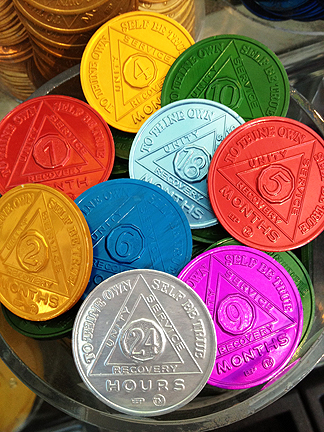One of the traditions in AA is collecting chips to commemorate milestones of sobriety time. The usual procession of chips is a 24-hour “desire” (to stay sober for the next day) chip, 30 days, 60 days, 90 days, 6 months, 9 months, 1 year, 18 months, and then yearly chips after that. Collecting chips is a great way to congratulate yourself on how far you’ve come in sobriety. Additionally, stepping forward to receive a chip during a meeting shows other alcoholics and addicts that it is indeed possible to stay sober. Often the receiving of a chip is accompanied by a brief account of “how we did it,” which can serve as an inspiration to others.
At Harmony Haus Sober Living in Austin, TX, we love celebrating our sober milestones with each other. Residents get a feeling of accomplishment and support when we hold dinners, parties, or just congratulatory meetings where residents can mark their continued sobriety.
The tradition of collecting sobriety chips is not, canonically, part of AA. There is no mention of sobriety chips in the Big Book or Twelve Steps and Twelve Traditions, for example. Like other AA traditions (such as having coffee at meetings!), the chip tradition seems to have sprung up organically from members’ desire to have something tangible and permanent to represent and remind them of their ongoing sobriety. In fact, the practice of giving sobriety chips in A.A. is attributed to a Group in Elmira, N.Y. in 1947. The celebration of birthdays came from the original Oxford Group (a group whose spiritual beliefs informed much of AA’s early work) where they celebrated the anniversary of their spiritual rebirth. People in early A.A. chose the anniversary of the date of their last drink.
Before that, the nun who helped Dr. Bob get the hospitalization program started at St. Thomas Hospital in Akron was the first person to use medallions in Alcoholics Anonymous. She gave the drunks who were leaving St. Thomas after a five day dry out a Sacred Heart Medallion and instructed them that the acceptance of the medallion signified a commitment to God, to A.A. and to recovery and that if they were going to drink, they had a responsibility to return the medallion to her before drinking. The sacred heart medallions had been used prior to A.A. by the Father Matthew Temperance Movement of the 1840’s and the Pioneers, an Irish Temperance Movement of the 1890’s.
Dr. Harry Tiebout (a renowned psychiatrist who was involved with AA early on) was asked to look at the problem of sobriety birthdays leading to a drinking bout and he commented on this phenomenon in an articled titled “When the Big “I” Becomes Nobody”, (AAGV, Sept. 65):
“Early on in A.A., I was consulted about a serious problem plaguing the local group. The practice of celebrating a year’s sobriety with a birthday cake had resulted in a certain number of the members getting drunk within a short period after the celebration. It seemed apparent that some could not stand prosperity. I was asked to settle between birthday cakes or no birthday cakes. Characteristically, I begged off, not from shyness but from ignorance. Some three or four years later, A.A. furnished me the answer. The group no longer had such a problem because, as one member said, “We celebrate still, but a year’s sobriety is now a dime a dozen. No one gets much of a kick out of that anymore.”
Nowadays, it seems like there are still some negative sides to the celebration of “AA birthdays.” Many people report having cravings around their sober anniversaries, for reasons that are not quite clear. Another, perhaps more urgent, issue, is that when a person “loses their sober time” or “turns in their chips” after a relapse, it can lead to a heightened sense of despair and failure. If we relapse, it is important not to succumb to the “abstinence violation phenomenon” wherein we are inclined to catastrophic thinking and self-loathing that leads us to truly throw in the towel and spiral out of control. Any steps to ameliorate this shame and guilt, such as the support of friends, sponsors, and the AA group, is critical. Thus, not being able to proudly state how much sober time one has, or to show others their chips, can be emotionally deleterious for the relapsed addict. It can add to a sense of shame and failure.
So, what is the right approach to measuring sober time and collecting chips? It is clear that collecting chips and marking sober milestones is extraordinarily encouraging to recovering addicts, especially for those in early recovery. It is up to individual AA’s and the AA group as a whole to help relapsed addicts navigate the sense of sadness and shame that may come from losing a length of consecutive sober time. The relapsed addict should be reminded that the time sober does not really “go away” and that nobody is upset at them or ashamed of them. And that the true value of sobriety is the joy we feel each day–not the color of the chips in our drawer.

